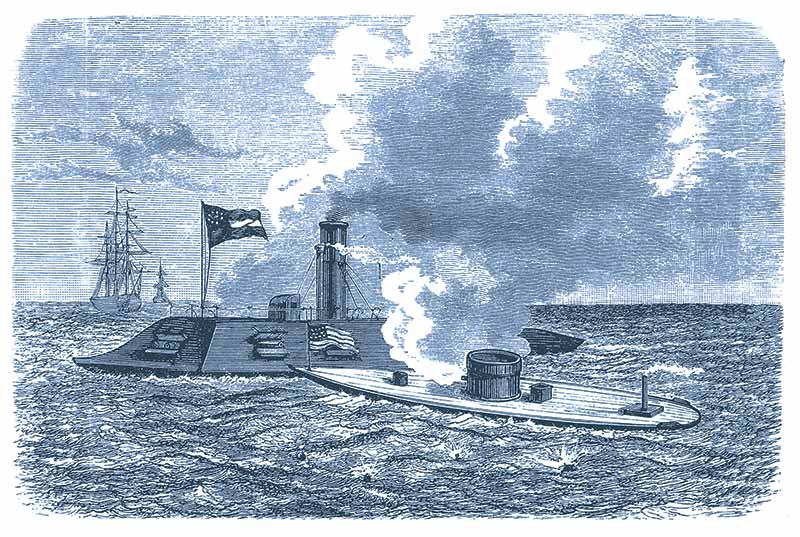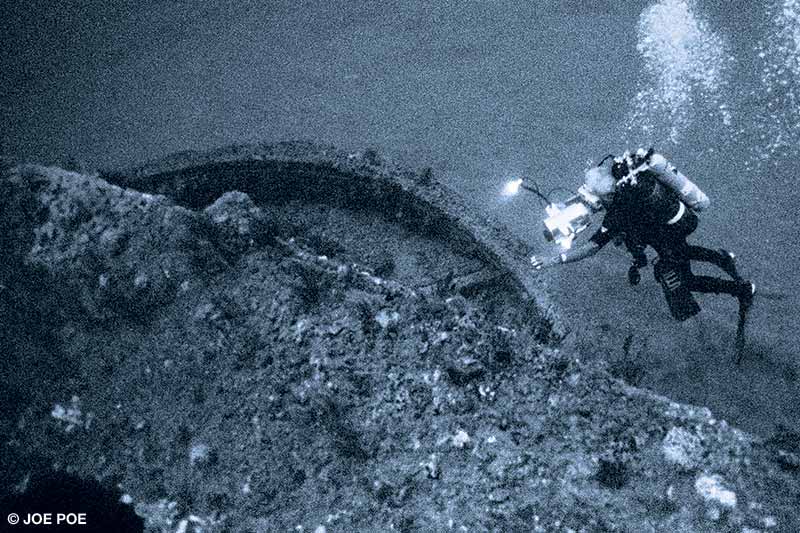In the 1990s and 2000s, I often ventured to the Graveyard of the Atlantic off the North Carolina coast on expeditions to dive 235 feet (72 meters) to the USS Monitor. In 1990 we had been the first non-NOAA divers to visit the wreck. Our task on this May 1993 expedition was to document one of the world’s most famous warships with still photography and video.

The first day of our dive expedition was a complete success in ideal conditions. But that night a strong wind whipped up the seas at the wreck site, and we had to cancel the next day’s dives. Two days later, everyone was eager to get back into the water — too eager, as it turned out.
There was a powerful current at the site, and the waves were high, but we decided to attempt the dive, which was our first mistake. My dive buddy and I quickly got ready and jumped in, thinking the rest of the team would set up the large tank of pure oxygen and surface-supply hoses we would need for our long decompression stops upon our return. Unlike today, when technical divers at this depth would prefer trimix, we were diving on air. Unfortunately, we hadn’t removed the extra 300-foot (91-meter) line full of knots that we had used to mark the existing buoy line for our previous dives. This was our second mistake, and we had to pull ourselves down almost 600 feet (183 meters) of line against the current.

I was carrying a large video-camera housing and two heavy batteries in addition to my other equipment. When we reached the Monitor, I was already exhausted, but the current seemed to grow stronger with each passing minute. We soon realized that the conditions weren’t cooperating and decided to surface before depleting our breathing gas.
Ascending the line was difficult. To keep from being pulled away by the current, I attached myself to the descent line with a short rope called a Jon line and moved it as I rose. Upon reaching the junction of the additional 300-foot (91-meter) line, I could not slide my Jon line over the knots, but I also couldn’t risk unhooking it to move it forward. I detached it from my harness, abandoned it and continued my ascent, holding the descent line by hand.
I began my decompression stops at 50 feet (15 meters) with additional stops every 10 feet (3 meters). At the 20-foot (6-meter) stop, another line streamed horizontally in the current from the descent line. I moved to the new line to decompress and realized I was running out of air, so I searched for the surface-supply hoses. They were not attached to the main line and were at the current’s whims, and none of the safety divers were visible — two more mistakes to add to the tally.

I was getting alarmed and had my hands full with the video camera, so I hooked my right leg around the horizontal line to avoid being swept away. The current caused this line to wrap around my ankle and tighten like a noose. At that moment I was completely out of air in my main tanks. I was carrying a 30-cubic-foot (0.85 cubic meter) safety cylinder, which should have provided plenty of oxygen to complete my decompression stops. I reached for its regulator, but I had not attached it to my harness as I usually did, and the roaring current had pulled it loose. I managed to grab it and inhaled nothing. I hadn’t closed the valve after charging it, so the current rushing past the mouthpiece had created a venturi effect and purged the tank. I was now trapped 20 feet (6 meters) beneath the surface with nothing to breathe and no one aware of my peril, hoping that my mistakes with the line and my breathing gas wouldn’t be my last.
I could see my buddy below me but could not reach or call him. With more time I could have cut the line with my knife, but lack of air diminished my options. I thought I was going to drown just 20 feet (6 meters) from the surface. This incident happened in seconds, but I remember thinking that my only hope was that one of the support divers would see me and get me to the surface in time to revive me. At some point I had tied the camera and batteries to one of the other lines, but I didn’t remember doing so and thought I had dropped them. I can’t recall when during my ascent this happened, but it must have been before running out of air, or it would have been a potentially fatal delay. If I were out of air, jettisoning the gear would have been necessary.
The next thing I knew I was at the surface, gasping for breath and coughing for help. I had skipped more than 30 minutes of decompression time and was worried that I had decompression sickness (DCS). Fortunately, the dive boat was close by, and within minutes I was hauled out of the water, stripped of my gear and given oxygen.

Members of my expedition team were well-versed in dive accident treatment and used a Doppler device to monitor me for bubbles. For more than three hours I stayed on my side, drank a lot of water and breathed pure oxygen with the hope that these first aid measures would prevent DCS, given my rapid ascent and missed decompression obligations. Despite the venous bubbles the Doppler showed, which can appear even on most uneventful dives, I never displayed any symptoms of DCS. I didn’t drown, and I didn’t lose any expensive equipment. I was lucky. By the time we got back to shore, I felt fine and had no symptoms. At that point in my dive career I didn’t realize the seriousness of my situation, and I failed to follow up with a physician evaluation — yet another mistake to add to the list.
How did I manage to free myself from the line and reach the surface? My dive boots were the old slip-on booties without a zipper. To avoid blisters from the middle seam, I always put a plastic baggie on my foot so the bootie would slide on and off more easily. An adrenaline surge enabled me to jerk my foot out of the boot and then fin and thrash to the surface. My dive buddy later told me he turned around at one point, saw my boot and fin wrapped in the line, and wondered where the heck I was.
My accident was the product of several mistakes and never should have occurred. I learned many lessons that day and believe I am a better diver for it. Throughout our many Monitor expeditions, hazardous as they may be, nobody has been seriously injured. Unfortunately, some of my dive partners on the Monitor have not been so lucky. Two of the team members have since died in accidents on other wrecks. I often think about them and remember that I almost paid the ultimate price for my “little” mistakes.
© Alert Diver — Q3/Q4 2021